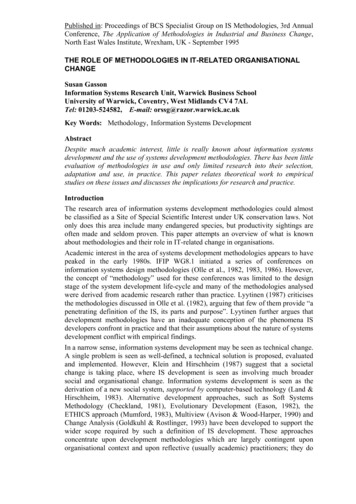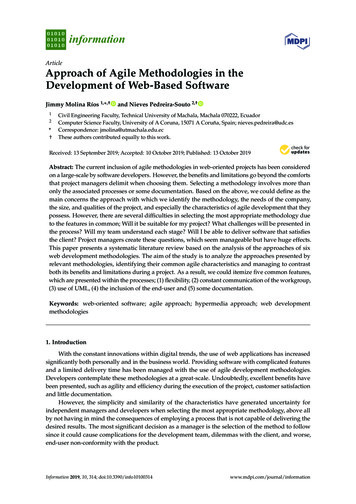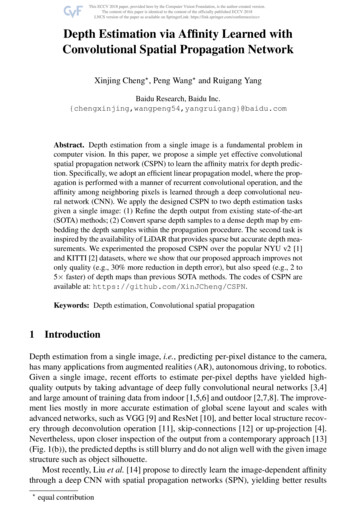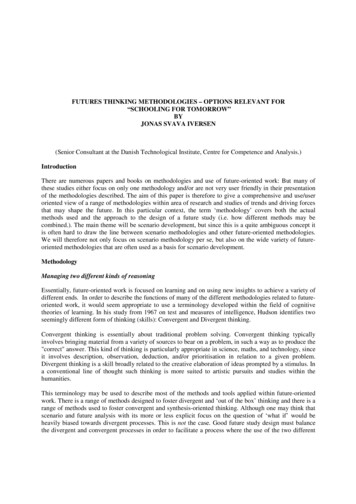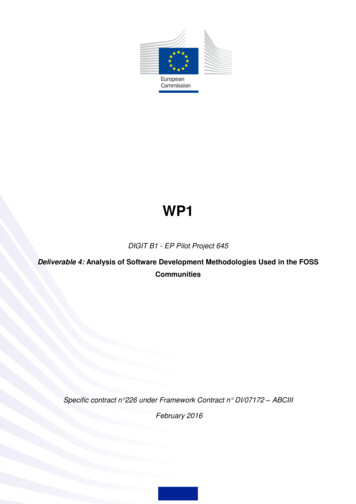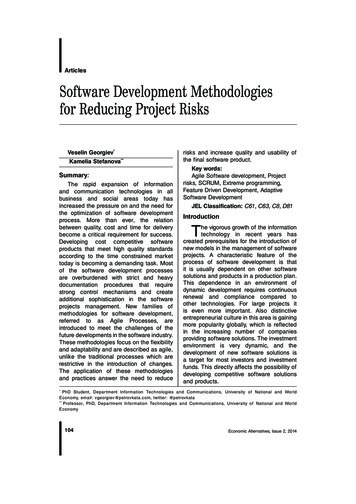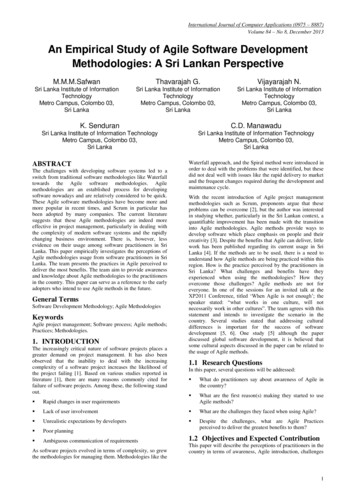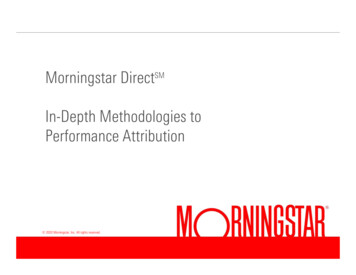
Transcription
Morningstar DirectSMIn-Depth Methodologies toPerformance Attribution 2020 Morningstar, Inc. All rights reserved. #
Outline Whatis Attribution Classic Attribution Key Decisions in Morningstar Direct Interpretation of Attribution Results Special Situations Future Enhancements2
What is Attribution?3
What is Performance Attribution?Definition Processof breaking down a portfolio’s return intocomponents that can be identified with types of decisions Stock Selection Sector and Industry Allocation Regional and Country Allocation Market Cap Allocation P/E and other valuation measures Accomplishedby using portfolio holdings4
Classic Attribution5
Classic AttributionBrinson Three-Factor Models ActiveReturn Weighting Effect Selection Effect Interaction “Interaction” Definition:the interaction between weighting and selection Consideration: “interaction” does not represent a decision6
Classic AttributionBrinson and Fachler (1985) Weighting w w ) ( R R )PjBjBjB7
Key Decisions8
Key Decision 1Investment Process: Top Down, Bottom Up, and Three Factor Two-FactorTop-Down Approach Weighting decisions before security selection Two-Factor Bottom-Up Approach Security selection before weighting decision Three-Factor Approach Order agnostic9
Key Decision 1Investment Process: Top Down Multiple Weighting Effects in Top-Down Approach Example: weighting decision made on sector, size, & capSmall-capWeighting EffectsValueCoreGrowthMicrosoftIBMEtc.Stock Selection10
Key Decision 1Investment Process: Top Down Hierarchical View of a U.S. Stock Portfolio11
Key Decision 1Investment Process: Top Down Multiple-Decision AttributionPortfolio WeightBenchmark uring20%10%AsiaAppearance: the three sectors in Asia appear overweightcompared to the benchmark (20% vs. 10%) Fact: the portfolio’s sector allocation is simply mimicking thebenchmark’s allocation (1/3 in each sector) Issue: the portfolio’s overweight in Asia makes each sector appearoverweight Æ don’t compare top level weights directly 12
Key Decision 1Investment Process: Top Down Anchoring Process in Top-Down AttributionPortfolio WeightBenchmark uring20%10%Asiax2Issue: the portfolio’s overweight in Asia makes each sectorappear overweight Solution: multiply benchmark sector weights by 2, since 2 isthe ratio between 60% and 30% 13
Key Decision 1Investment Process: Bottom Up Bottom-UpApproach Security selection before weighting decision14
Key Decision 1Investment Process: Bottom Up Multiple-Decision AttributionPortfolio WeightBenchmark Weight60%30%Stock 120%10%Stock 220%10%Stock 320%10%Business Services Appearance: the three securities in Business Services Sector appearoverweight compared to the benchmark (20% vs. 10%) Fact: the portfolio’s security allocation is simply mimicking thebenchmark’s allocation (1/3 in each security) Issue: the portfolio’s overweight in Business Services makes eachsecurity appear overweight Æ don’t compare security weight directly15
Key Decision 1Investment Process: Bottom Up Anchoring Process in Bottom-Up AttributionPortfolio WeightBenchmark Weight60%30%Stock 120%10%Stock 220%Stock 320%Business Servicesx 0.510%10% Issue: the portfolio’s overweight in the Business Servicessector makes each security appear overweight Solution: multiple portfolio security weights by 0.5, since0.5 is the ratio between 30% and 60%16
Key Decision 1Investment Process: Three Factor ThreeFactor Approach Agnostic view on order of investment decision Same anchoring process as the two-factor bottom-up approach17
Key Decision 1Investment Process: Three Factor ThreeFactor Approach Agnostic view on the order of investment decision18
Key Decision 1Investment Process: Three Factor ThreeFactor Approach Interaction is at sector level only, since it is the interactionbetween weighting and selection effects.( w Pj w Bj ) ( R Pj R Bj )19
Key Decision 1Investment Process: Three Factor vs. Top Down0.42 (-0.18) 0.2420
Key Decision 1Investment Process: Three Factor vs. Bottom Up0.31 (-0.18) 0.1321
Key Decision 2Multi-Period Linking: Arithmetic vs. Geometric Arithmeticvs. Geometric Example: portfolio return 12%, benchmark return 10%Arithmetic Method Active Return Rp – Rb 12% - 10% 2% Active Return Wt Effect Sel EffectGeometric Method Active Return (1 Rp) / (1 Rb) - 1 1.12 / 1.10 – 1 1.82% Active Return (1 Wt Effect) x (1 Sel Effect) - 122
Key Decision 2Multi-Period Linking: Geometric Method SinglePeriod x23
Key Decision 2Multi-Period Linking: Geometric Method MultiPeriodOctNovxDecOct – Dec(1 Oct) x (1 Nov) x (1 Dec) – 124
Key Decision 2Multi-Period Linking: Geometric Method Characteristics Theoreticallyand mathematically sound Multi-period: no sector-level details because each sector inisolation does not represent a complete decisionSingle PeriodMulti-Period25
Key Decision 2Multi-Period Linking: Arithmetic Method SinglePeriod 26
Key Decision 2Multi-Period Linking: Arithmetic Method MultiPeriodOctNov “Smoothing” is requiredDecOct – Dec27
Key Decision 2Multi-Period Linking: Arithmetic Method Reasonfor smoothing: Excess Return Active Return28
Key Decision 2Multi-Period Linking: Arithmetic Methodsmoothing: Excess Return Active Return Excess Return October to December -4.66% Without ActiveReturn October to December -4.83% w/o smoothing 29
Key Decision 2Multi-Period Linking: Arithmetic Methodsmoothing: Excess Return Active Return Excess Return October to December -4.66% After ActiveReturn30
Key Decision 2Multi-Period Linking: Arithmetic Method Characteristics Simple,intuitive Multi-period: requires mathematical “smoothing” Multi-period: offers sector-level details31
Key Decision 3Inferring Forward or Backward In Time When portfolio holdings are not available: ExampleNeed Attribution analysis period from Apr 1 to Jun 30Æ need Mar 31 portfolio holdingsHave Portfolio has holdings information on Feb 28 andApr 30 but not Mar 3132
Key Decision 3Inferring Forward or Backward In Time Oursolution Use buy-and-hold assumption to infer Mar 31 holdings datafrom nearby datesMar 31Feb 28Inferred ForwardApr 30Inferred Backward33
Interpretation of Attribution Results34
Interpretation of Attribution Results Top-DownInvestment (w w ) ( R R )PjBjBjB35
Interpretation of Attribution ResultsTop-Down: Total Equity Level Portfoliounderperformed by 3.64% Poor sector weighting decision Æ -0.56% Poor security selection decision Æ -3.07% 36
Interpretation of Attribution ResultsTop-Down: Sector Level Poorsector weighting and security selection decisions in Energy37
PoorOutperformUnderweight OverweightInterpretation of Attribution ResultsTop-Down: Sector Weighting EffectUnderperformsector weighting decision in Energy, resulting in -0.30% Energy overweighted Æ 2.29% Sector underperformed the total Æ -14.02% vs. -0.82%38
OutperformUnderweight OverweightInterpretation of Attribution ResultsTop-Down: Selection EffectUnderperform HoldingCanadian Natural Resources was the worst decision Æ -0.33% Security overweighted Æ 4.34% vs. 0% Security underperformed the sector Æ -21.51% vs. -14.02%39
OutperformUnderweight OverweightInterpretation of Attribution ResultsTop-Down: Selection EffectUnderperform ExxonMobil:what you don’t own can also hurt Æ -0.25% Security underweighted Æ 0% vs. 4.18% Security outperformed the sector Æ -8.74% vs. -14.02%40
OutperformUnderweight OverweightInterpretation of Attribution ResultsTop-Down: Selection EffectUnderperform Challenge: why is Motorola a detractor in Hardware? Æ -0.01%Overweight: 0.20% vs. 0.15%Outperformance: 17.71% vs. 1.32%41
Interpreting Attribution ResultsTop-Down: Anchoring on Prior Decision Anchoring Process in Top-Down AttributionPortfolio WeightBenchmark uring20%10%Asiax2Issue: the portfolio’s overweight in Asia makes each sectorappear overweight Solution: multiply benchmark sector weights by 2, since 2 isthe ratio between 60% and 30% 42
OutperformUnderweight OverweightInterpretation of Attribution ResultsTop-Down: Selection EffectUnderperform Correct interpretationMust anchor on prior decisionBenchmark weight of 0.15% becomes 0.26% after anchoringMotorola is actually underweight Æ 0.20% vs. 0.25%0.15 x 17.20 / 9.84 0.2543
Interpretation of Attribution Results Bottom-UpInvestment (w w ) ( R R )PjBjPjB44
GoodOutperformUnderweight OverweightInterpretation of Attribution ResultsBottom-Up: Sector Weighting EffectUnderperformsector weighting decision in Consumer Goods, resulting in 0.17% Consumer Goods underweighted Æ -7.15% Sector underperformed the total Æ -3.24% vs. -0.82%45
OutperformUnderweight OverweightInterpretation of Attribution ResultsBottom-Up: Selection EffectUnderperform Challenge:why is PPL Corporation a detractor in Utilities? Æ -0.01% Underweight: 0.07% vs. 0.17% Underperformance: -10.16 vs. -5.59%46
Interpretation of Attribution ResultsBottom-Up: Selection Effect Anchoring Process in Bottom-Up AttributionPortfolio WeightBenchmark Weight60%30%Stock 120%10%Stock 220%Stock 320%Business Servicesx 0.510%10% Issue: the portfolio’s overweight in the Business Servicessector makes each security appear overweight Solution: multiple portfolio security weights by 0.5, since0.5 is the ratio between 30% and 60%47
OutperformUnderweight OverweightInterpretation of Attribution ResultsBottom-Up: Selection EffectUnderperform Correct interpretation of PPL CorporationMust anchor on prior hierarchyPortfolio weight of 0.07% becomes 0.30% after anchoringPPL is actually overweight Æ 0.30% vs. 0.17%0.07 x 3.88 / 0.90 0.3048
Interpretation of Attribution ResultsInvestment ProcessUnderperformOutperformUnderweightOverweight Three-Factor(w w ) ( R R )PjBjBjB49
GoodOutperformUnderweight OverweightInterpretation of Attribution ResultsThree-Factor: Sector Weighting EffectUnderperformsector weighting decision in Consumer Goods, resulting in 0.15% Consumer Goods underweighted Æ -8.53% Sector underperformed the total Æ -0.66% vs. 1.06%50
OutperformUnderweight OverweightInterpretation of Attribution ResultsThree-Factor: Selection EffectUnderperform Poorsecurity selection decision in Nike, resulting in -0.14% Must anchor on prior hierarchy Security overweighted Æ 4.87% vs. 0.27% Security underperformed the sector Æ -3.76% vs. -0.66%1.01 x 10.76 / 2.23 4.8751
PoorOutperformUnderweight OverweightInterpretation of Attribution ResultsThree-Factor: InteractionUnderperforminteraction of decisions in Consumer Goods, resulting in -0.61% Consumer Goods underweighted Æ -8.53% Sector active management outperformed passive Æ 7.19%52
Special Situation53
Special Situation IShort Positions Attributionanalysis must be performed on the short positionsseparately from the long positions54
Special Situation IIGroups without Holdings Condition1 If neither the portfolio nor the benchmark has holdings in aparticular group, this group is ignored during attributionanalysis55
Special Situation IIGroups without Holdings (continued) Condition 2 If the portfolio does not have holdings in a particular group, thenportfolio return benchmark return¾ Attribution result reflects sector weighting decision¾ Attribution results are zero for subsequent decisions56
Special Situation IIGroups without Holdings (continued) Condition 3 If the benchmark does not have holdings in a particular group and thisgroup contains long positions, then benchmark return portfolioreturn¾ Attribution result reflects sector weighting decision¾ Attribution results sum to zero for subsequent decisions57
Special Situation IIGroups without Holdings (continued) Condition 4 If the benchmark does not have holdings in a particular group, andthis group contains short positions, then benchmark return of shortposition benchmark return of long position counterpart58
Future Enhancements59
Future Enhancements 3.6.1 (March 2009) ThreeFactor Model Multi-Manager TwoAttribution for Fund-of-Funds and Aggregates (Asset Level)portfolios vs. One benchmark Output Display“Reported” Return by Fund Manager vs. “Attribution” Return Executive Summary Attribution Export Holdings Data View of Portfolio and Benchmark Holding DatesData to Expand and Collapse GroupingsComing Soon Chart and Reports Batch Scheduling Currency Attribution, Transaction-Based Attribution, Basic Fixed IncomeAttribution60
61
Classic Attribution Brinson Three-Factor Models Active Return Weighting Effect Selection Effect Interaction "Interaction" Definition: the interaction between weighting and selection Consideration: "interaction" does not represent a decision
